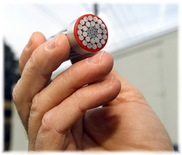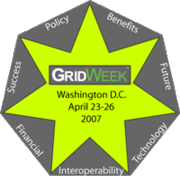
We can double the power delivered by all of our power plants by simply changing the wires that run from the plants to the customers.
Right now more than half of all electric power generated in America, no matter how it is generated, is lost because the conducting wires which bring it to market are not really great conductors.
Researchers are the Oak Ridge National Laboratory have been working on the problem for years. In 2004 they announced the first commercial sale of a cable, by 3M to Xcel Energy, with a ceramic core inside an aluminum-zirconium matrix. (Conventional cables have a core of steel.) The new cables carry 1.5-3 times more electricity to market than those they replace.
They also hold up better to the elements and they don’t "sag" as much. This means they don’t expand as much under high load, in the summer, meaning there is less risk that they will fall into a tree and cut out power to millions, as happens. The cable costs more than steel, but the return is enormous.
Oak Ridge has also been working on a technology called Rolling
Assisted, Biaxially Textured Substrates (RABITS), with a Massachusetts
outfit called American Superconductor.
The idea is to make metal into a crystal by rolling and annealing it
into a thin tape, then transferring that pattern onto a superconductive
oxide such as Yttrium Barium Copper Oxide. The company has a PDF presentation on the savings it offers and will help sponsor a "grid modernization show" called GridWeek next month in Washington.
All these changes cost money, but the investment comes back in the
form of a higher yield from every watt generated and (often) in the
reliability of the resulting electric grid in extreme conditions.
The
next time your local electric utility demands the right to put in a new
power plant, claiming that demand requires the capacity, ask them how
much power they lose in their grid each day, and what they’re doing
about it.












Meanwhile, while they’re upgrading lines, the power companies can also be rolling out fiber in parallel for very little incremental cost. A nice FTTN network with BPL for the last 100m would be at least as good as the Project Lightspeed network that AT&T is rolling out ever so slowly.
Meanwhile, while they’re upgrading lines, the power companies can also be rolling out fiber in parallel for very little incremental cost. A nice FTTN network with BPL for the last 100m would be at least as good as the Project Lightspeed network that AT&T is rolling out ever so slowly.